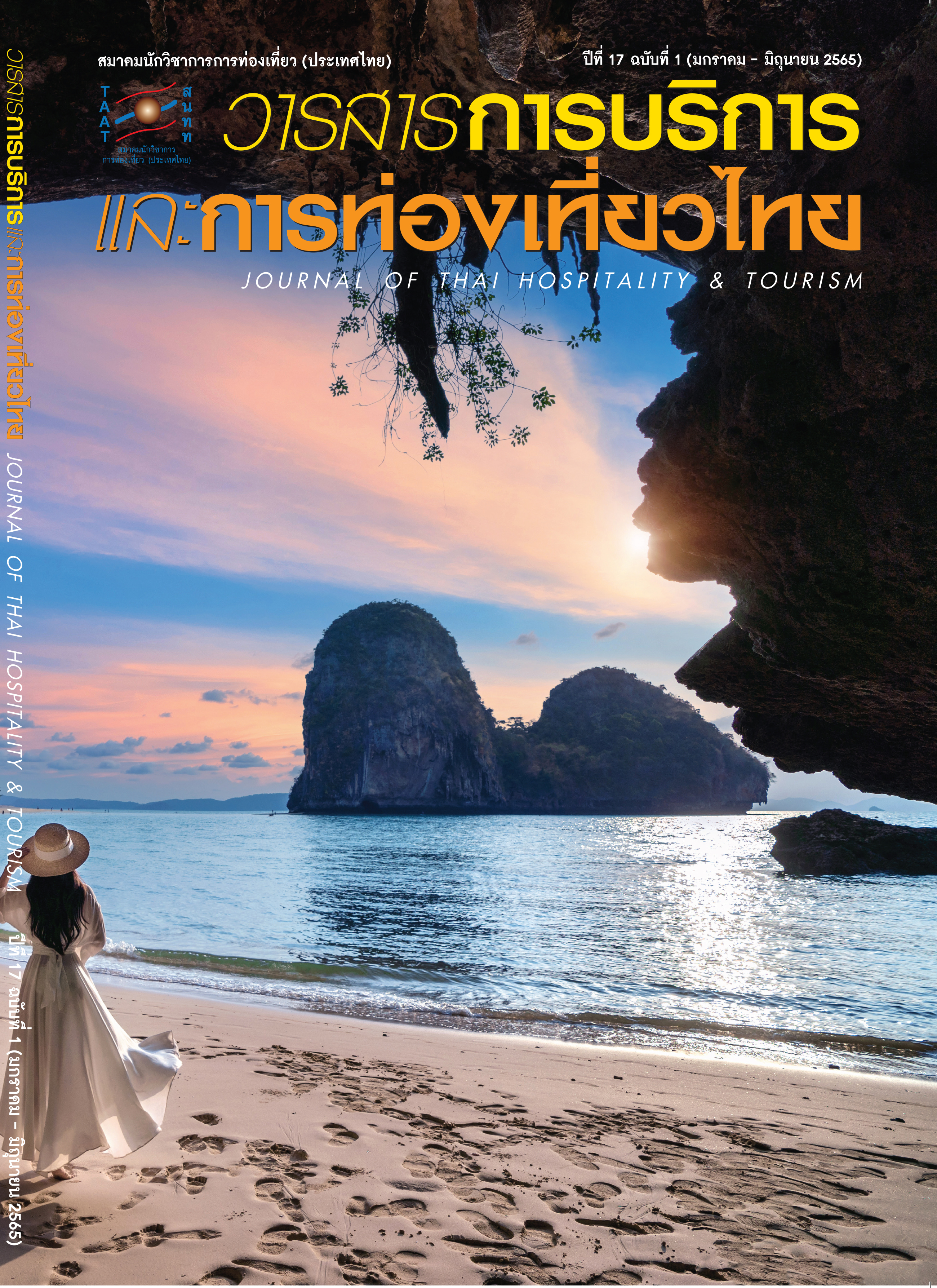การทบทวนปัจจัยสี่ประการในฐานะตัวสนับสนุนความเหนื่อยหน่ายในอุตสาหกรรม โรงแรม : รูปแบบแนวคิดของแหล่งที่มาของความเหนื่อยหน่าย
Main Article Content
บทคัดย่อ
บทความนี้ได้นำเสนอกรอบแนวคิดสำหรับการศึกษาแหล่งที่มาของความเหนื่อยหน่ายของพนักงานในอุตสาหกรรมโรงแรมในประเทศไทย การทบทวนและการระบุถึงปัจจัยที่เป็นแหล่งที่มาของความเหนื่อยหน่ายถือได้ว่าเป็นประเด็นสำคัญที่ทำให้เข้าใจถึงปรากฏการณ์ของความเหนื่อยหน่ายอันนำไปสู่การรักษาพนักงาน ลดความขาดแคลนของพนักงาน รวมถึงการเตรียมความพร้อมสำหรับอุตสาหกรรมโรงแรมในการรับมือกับสภาพแวดล้อมทางธุรกิจที่เปลี่ยนแปลงไปอย่างรวดเร็ว บทความนี้มุ่งนำเสนอการทบทวนแหล่งที่มาของความความเหนื่อยหน่ายจากวรรณกรรมในปัจจุบันเพื่อสร้างกรอบแนวคิดสำหรับการบูรณาการแหล่งที่มาของความความเหนื่อยหน่ายในอนาคต โดยการศึกษามุ่งพิจารณา ความขัดแย้ง ความเครียดในงาน การจัดแจงในงาน และรางวัลเป็นปัจจัยหลักที่ใช้บูรณาการและเสนอแนวทางในการอธิบายปรากฏการณ์ของความเหนื่อยหน่ายในปี ค.ศ. 2020 ซึ่งประโยชน์ของข้อค้นพบไม่เพียงนำไปสู่การขยายองค์ความรู้ของทฤษฏีความเหนื่อยหน่าย ทั้งยังสร้างประโยชน์ให้แก่อุตสาหกรรมบริการหลังจากกรอบแนวคิดนี้ได้รับการทดสอบ โดยเฉพาะอย่างยิ่งในการจัดการระดับความเหนื่อยหน่ายในงานด้วยปัจจัยทั้งสี่ดังที่กล่าวมา
Article Details

อนุญาตภายใต้เงื่อนไข Creative Commons Attribution-NonCommercial-NoDerivatives 4.0 International License.
เอกสารอ้างอิง
Borysenko, K. (2019). Burnout is now an Officially Diagnosable Condition: Here’s What You Need to Know About It. Retrieved from http://www.forbes.com/sites/karlynborysenko/2019/05/29/burnout-is-now-an-officially-diagnosable-condition-heres-what-you-need-to-know-about-it/#56f31fcc2b99
Cheng, J. C. & Yi, O. (2018). Hotel Employee Job Crafting, Burnout, and Satisfaction: the Moderating Role of Perceived Organizational Support. International Journal of Hospitality Management, 72, 78–85.
Chiang, C. F. & Liu, B. Z. (2017). Examining Job Stress and Burnout of Hotel Room Attendants: Internal Marketing and Organizational Commitment as Moderators. Journal of Human Resources in Hospitality and Tourism, 16(4), 367–383.
Choi, H. M., Mohammad, A. A. & Kim, W. G. (2019). Understanding Hotel Frontline Employees’ Emotional Intelligence, Emotional Labor, Job Stress, Coping Strategies and Burnout. International Journal of Hospitality Management, 82, 199–208.
Deliotte Touche Tohmatsu Limited. (2020). Workplace Burnout Survey: Burnout without Borders. Retrieved from http://www2.deliotte.com/us/en/pages/about-deliotte/articles/burnout-survey.html
Hok, Y. C. (2019). Market Snapshot: Asia Pacific 2019. Retrieved from http://www.hospitalitynet.org/opinion/4095789.html
Horwath HTL. (2018). Asia Pacific Chains & Hotels Report. Retrieved from http://www.hospitalitynet.org/file/152008555.pdf
Jiraratchanirom, J. (2017). Hotel is Still Lacking Labor. Retrieved from http://www.posttoday.com/economy/news/473869
Koo, B., Yu, J., Chua, B. L., Lee, S. & Han, H. (2019). Relationships among Emotional and Material Rewards, Job Satisfaction, Burnout, Affective Commitment, Job Performance, and Turnover Intention in the Hotel Industry. Journal of Quality Assurance in Hospitality and Tourism, 8, 1–31.
Lunkam, P. (2019). Thailand Industry Outlook 2019–21: Hotel Industry. Retrieved from http://www.krungsri.com/bank/getmedia/25d80eb0-c9cf-483b-82e5-b800c6eac269/IO_Hotel_190731_EN_EX.aspx
Mansour, S. & Tramblay, D. G. (2016). How the Need for “Leisure Benefit Systems” as A “Resource Passageways” Moderates the Effect of Work-Leisure Conflict on Job Burnout and Intention to Leave: A Study in the Hotel Industry in Quebec. Journal of Hospitality and Tourism Management, 27, 4–11.
Mansour, S. & Tremblay, D. G. (2018). Work–Family Conflict/Family-Work Conflict, Job Stress, Burnout and Intention to Leave in the Hotel Industry in Quebec (Canada): Moderating Role of Need for Family Friendly Practices as “Resource Passageways”. The International Journal of Human Resource Management, 29(16), 2399–2430.
Maslach, C. & Jackson, S. E. (1981). The Measurement of Experienced Burnout. Journal of Organizational Behavior, 2(2), 99–113.
Paychex. (2019). Feeling the Burn (Out): Exploring How Employees Overcome Burnout. Retrieved from http://www.paychex.com/articlees/human-resource/impact-of-employee-burnout
Thai Civil Rights and Investigative Journalism. (2017). In the Year 2017, Thai People Resign from 9.6 Billion to 1.3 Hundred Thousand People/Month. Retrieved from http://www.tcijthai.com/news/2017/31/scoop/7633
Wen, B., Zhou, X., Hu, Y. & Zhang, X. (2020). Role Stress and Turnover Intention of Front-Line Hotel Employees: the Roles of Burnout and Service Climate. Frontiers in Psychology, 11, 1–13.
World Health Organization. (2019). Burn-out An “Occupational Phenomenon”: International Classification of Diseases. Retrieved from http://www.who.int/mental_health/evidence/burn-out
Zion Market Research. (2019). Global Hotels Market Expected to Reach USD 211.54 Billion By 2025: Zion Market Research. Retrieved from http:www.globenewswire.com/news-release/2019/03/08/1750501/0/en/global-hotels-market-expected-to-reach-usd-211-54-billion-by-2025-zion-market-research.html


